
HuatuoGPT-o1
Medical o1, Towards medical complex reasoning with LLMs
Stars: 480
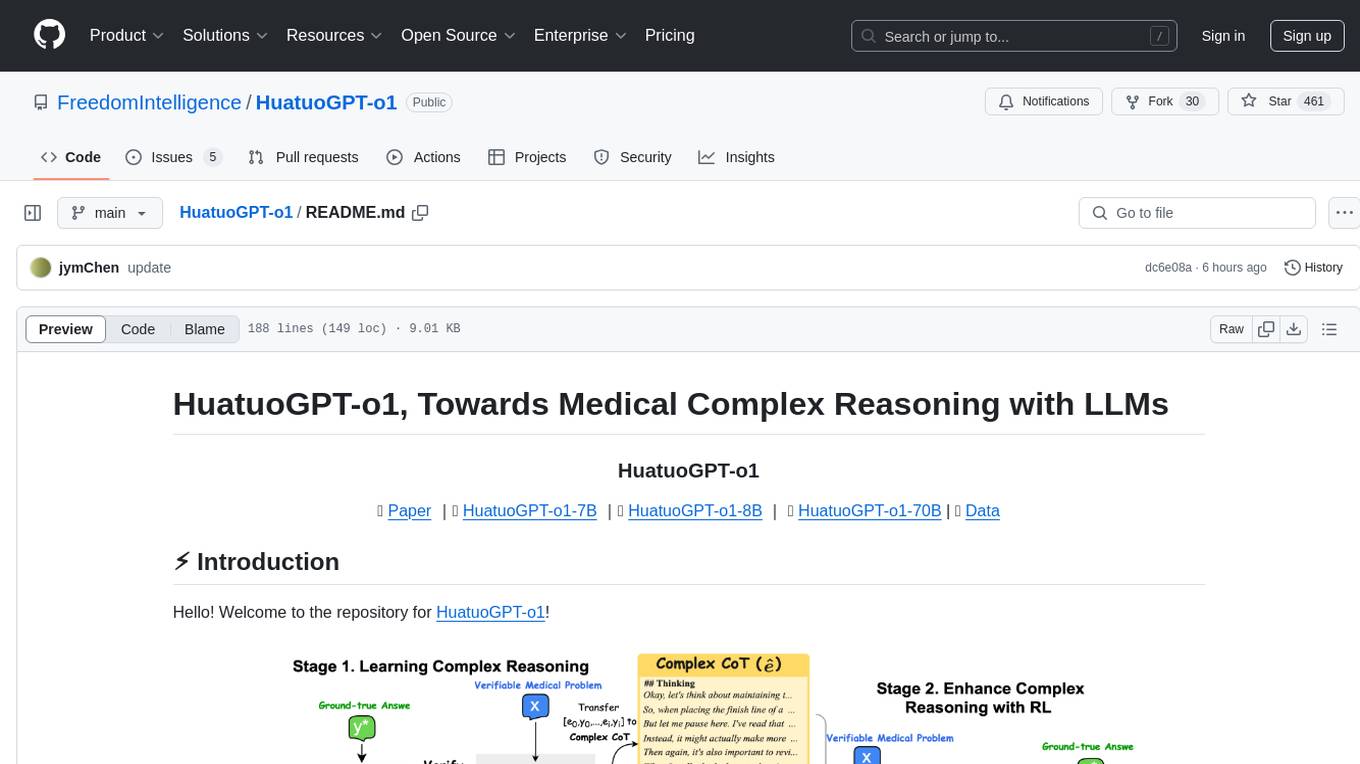
HuatuoGPT-o1 is a medical language model designed for advanced medical reasoning. It can identify mistakes, explore alternative strategies, and refine answers. The model leverages verifiable medical problems and a specialized medical verifier to guide complex reasoning trajectories and enhance reasoning through reinforcement learning. The repository provides access to models, data, and code for HuatuoGPT-o1, allowing users to deploy the model for medical reasoning tasks.
README:
📃 Paper |🤗 HuatuoGPT-o1-7B |🤗 HuatuoGPT-o1-8B | 🤗 HuatuoGPT-o1-70B | 📚 Data
Hello! Welcome to the repository for HuatuoGPT-o1!
HuatuoGPT-o1 is a medical LLM designed for advanced medical reasoning. It can identify mistakes, explore alternative strategies, and refine its answers. By leveraging verifiable medical problems and a specialized medical verifier, it advances reasoning through:
- Using the verifier to guide the search for a complex reasoning trajectory for fine-tuning LLMs.
- Applying reinforcement learning (PPO) with verifier-based rewards to enhance complex reasoning further.
We open-sourced our models, data, and code here.
- Model Access
| Backbone | Supported Languages | Link | |
|---|---|---|---|
| HuatuoGPT-o1-8B | LLaMA-3.1-8B | English | HF Link |
| HuatuoGPT-o1-70B | LLaMA-3.1-70B | English | HF Link |
| HuatuoGPT-o1-7B | Qwen2.5-7B | English & Chinese | HF Link |
| HuatuoGPT-o1-72B | Qwen2.5-72B | English & Chinese | HF Link |
- Deploy
HuatuoGPT-o1 can be used just like Llama-3.1-8B-Instruct. You can deploy it with tools like vllm or Sglang, or perform direct inference:
from transformers import AutoModelForCausalLM, AutoTokenizer
model = AutoModelForCausalLM.from_pretrained("FreedomIntelligence/HuatuoGPT-o1-8B",torch_dtype="auto",device_map="auto")
tokenizer = AutoTokenizer.from_pretrained("FreedomIntelligence/HuatuoGPT-o1-8B")
input_text = "How to stop a cough?"
messages = [{"role": "user", "content": input_text}]
inputs = tokenizer(tokenizer.apply_chat_template(messages, tokenize=False,add_generation_prompt=True
), return_tensors="pt").to(model.device)
outputs = model.generate(**inputs, max_new_tokens=2048)
print(tokenizer.decode(outputs[0], skip_special_tokens=True))HuatuoGPT-o1 adopts a thinks-before-it-answers approach, with outputs formatted as:
## Thinking
[Reasoning process]
## Final Response
[Output]
- Data Access
| Data | Description | Link |
|---|---|---|
| Medical Verifiable Problems | Open-ended medical problems sourced from challenging medical exams, paired with ground-truth answers. | Link |
| SFT Data in Stage 1 | Fine-tuning data generated using GPT-4o, including complex chains of thought (Complex CoT) and output (Response). | Link |
- Data Construction
We provide scripts to construct verifiable problems and searching reasoning paths.
1. Constructing Verifiable Problems from Multi-choice Questions.
python construct_verifiable_medical_problems.py --data_path data/demo_data.json --filter_data --model_name gpt-4o --api_key [your api key]2. Searching Complex Reasoning Paths for SFT
python search_for_complex_reasoning_path.py --data_path data/demo_data.json --efficient_search True --max_search_attempts 1 --max_search_depth 2 --model_name gpt-4o --api_key [your api key]- Stage 1: Supervised Fine-Tuning (SFT)
Fine-tune the model on an 8-GPU setup:
accelerate launch --config_file ./configs/deepspeed_zero3.yaml \
--num_processes 8 \
--num_machines 1 \
--machine_rank 0 \
--deepspeed_multinode_launcher standard SFT_stage1.py \
--model_path [meta-llama/Llama-3.1-8B-Instruct] \
--data_path [FreedomIntelligence/medical-o1-reasoning-SFT] - Stage 2: Reinforcement Learning (RL)
We provide a simple PPO script using the trl library. Below is an example for training an 8B model with PPO on an 8-GPU A100 machine. Ensure you first download our medical verifier as the reward model.
accelerate launch \
--num_processes 8 \
--num_machines 1 \
--machine_rank 0 \
--config_file ./configs/deepspeed_zero3.yaml \
--deepspeed_multinode_launcher standard RL_stage2.py \
--model_name_or_path [FreedomIntelligence/HuatuoGPT-o1-8B] \
--reward_model_path [FreedomIntelligence/medical_o1_verifier_3B] \
--value_model_path [meta-llama/Llama-3.2-3B-Instruct] \
--dataset_name [FreedomIntelligence/medical-o1-verifiable-problem]\
--response_length 1300 \
--temperature 0.5 \
--local_rollout_forward_batch_size 8 \
--num_ppo_epochs 3 \
--num_mini_batches 1 \
--total_episodes 20000 \
--per_device_train_batch_size 1 \
--gradient_accumulation_steps 16 \
--bf16 True \
--output_dir ./ckpts \
--save_strategy steps \
--save_step 20 \
--save_total_limit 1 \
--eval_strategy steps \
--eval_steps 20 \
--kl_coef 0.03 \
--learning_rate 5e-7 \
--warmup_ratio 0.05 \
--gradient_checkpointing True \
--dataloader_num_workers 4 \
--run_name ppo_medical_o1_8B \
--num_sample_generations -1 \
--report_to wandb- You first need to install Sglang. After installation, deploy the model you want to test using Sglang with the following command:
log_num=0
model_name="FreedomIntelligence/HuatuoGPT-o1-8B" # Path to the model you are deploying
port=28${log_num}35
CUDA_VISIBLE_DEVICES=0 python -m sglang.launch_server --model-path $model_name --port $port --mem-fraction-static 0.8 --dp 1 --tp 1 > sglang${log_num}.log 2>&1 &- Wait for the model to be deployed. After deployment, you can run the following code for evaluation. We use prompts that allow the model to respond freely. We find that the extracted results are consistently reliable and broadly cover the intended scope. You can also set the
--strict_promptoption to use stricter prompts for more precise answer extraction.
python evaluation/eval.py --model_name $model_name --eval_file evaluation/data/eval_data.json --port $port - After completing the evaluation, run the following code to stop the Sglang service and release GPU memory.
bash evaluation/kill_sglang_server.shThe evaluation code above can be used to test most models supported by Sglang.
Explore our HuatuoGPT series:
- HuatuoGPT: Taming Language Models to Be a Doctor
- HuatuoGPT-II: One-stage Training for Medical Adaptation of LLMs
- HuatuoGPT-Vision: Injecting Medical Visual Knowledge into Multimodal LLMs at Scale
- CoD (Chain-of-Diagnosis): Towards an Interpretable Medical Agent using Chain of Diagnosis
- HuatuoGPT-o1: Towards Medical Complex Reasoning with LLMs
@misc{chen2024huatuogpto1medicalcomplexreasoning,
title={HuatuoGPT-o1, Towards Medical Complex Reasoning with LLMs},
author={Junying Chen and Zhenyang Cai and Ke Ji and Xidong Wang and Wanlong Liu and Rongsheng Wang and Jianye Hou and Benyou Wang},
year={2024},
eprint={2412.18925},
archivePrefix={arXiv},
primaryClass={cs.CL},
url={https://arxiv.org/abs/2412.18925},
}
For Tasks:
Click tags to check more tools for each tasksFor Jobs:
Alternative AI tools for HuatuoGPT-o1
Similar Open Source Tools

HuatuoGPT-o1
HuatuoGPT-o1 is a medical language model designed for advanced medical reasoning. It can identify mistakes, explore alternative strategies, and refine answers. The model leverages verifiable medical problems and a specialized medical verifier to guide complex reasoning trajectories and enhance reasoning through reinforcement learning. The repository provides access to models, data, and code for HuatuoGPT-o1, allowing users to deploy the model for medical reasoning tasks.
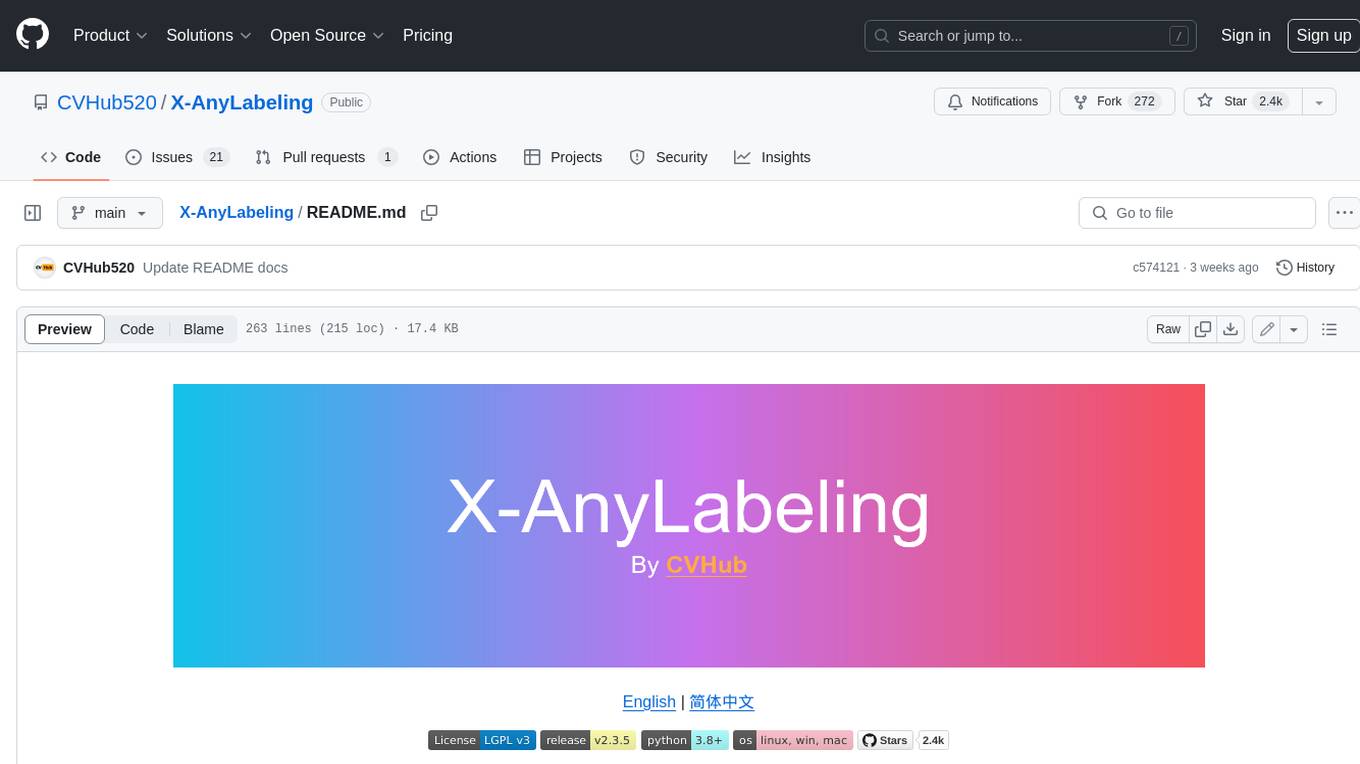
X-AnyLabeling
X-AnyLabeling is a robust annotation tool that seamlessly incorporates an AI inference engine alongside an array of sophisticated features. Tailored for practical applications, it is committed to delivering comprehensive, industrial-grade solutions for image data engineers. This tool excels in swiftly and automatically executing annotations across diverse and intricate tasks.
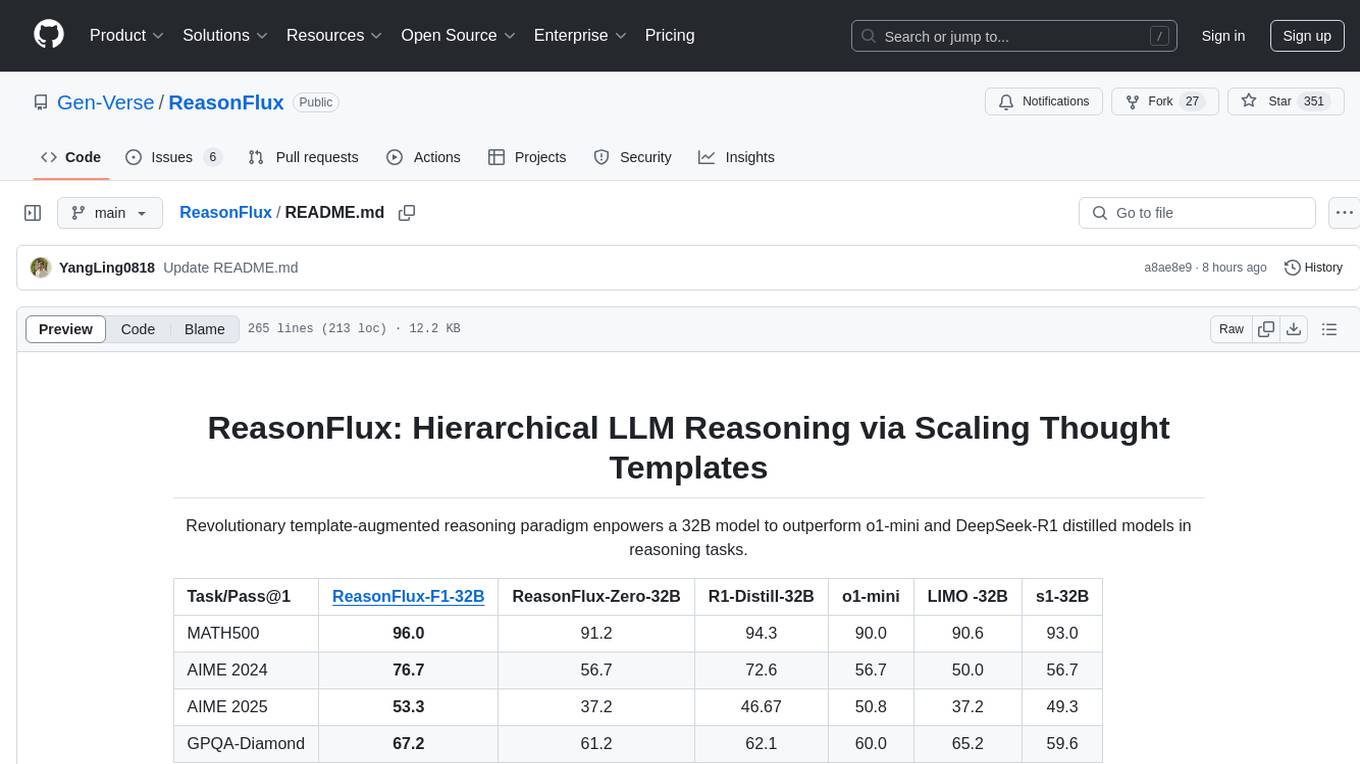
ReasonFlux
ReasonFlux is a revolutionary template-augmented reasoning paradigm that empowers a 32B model to outperform other models in reasoning tasks. The repository provides official resources for the paper 'ReasonFlux: Hierarchical LLM Reasoning via Scaling Thought Templates', including the latest released model ReasonFlux-F1-32B. It includes updates, dataset links, model zoo, getting started guide, training instructions, evaluation details, inference examples, performance comparisons, reasoning examples, preliminary work references, and citation information.
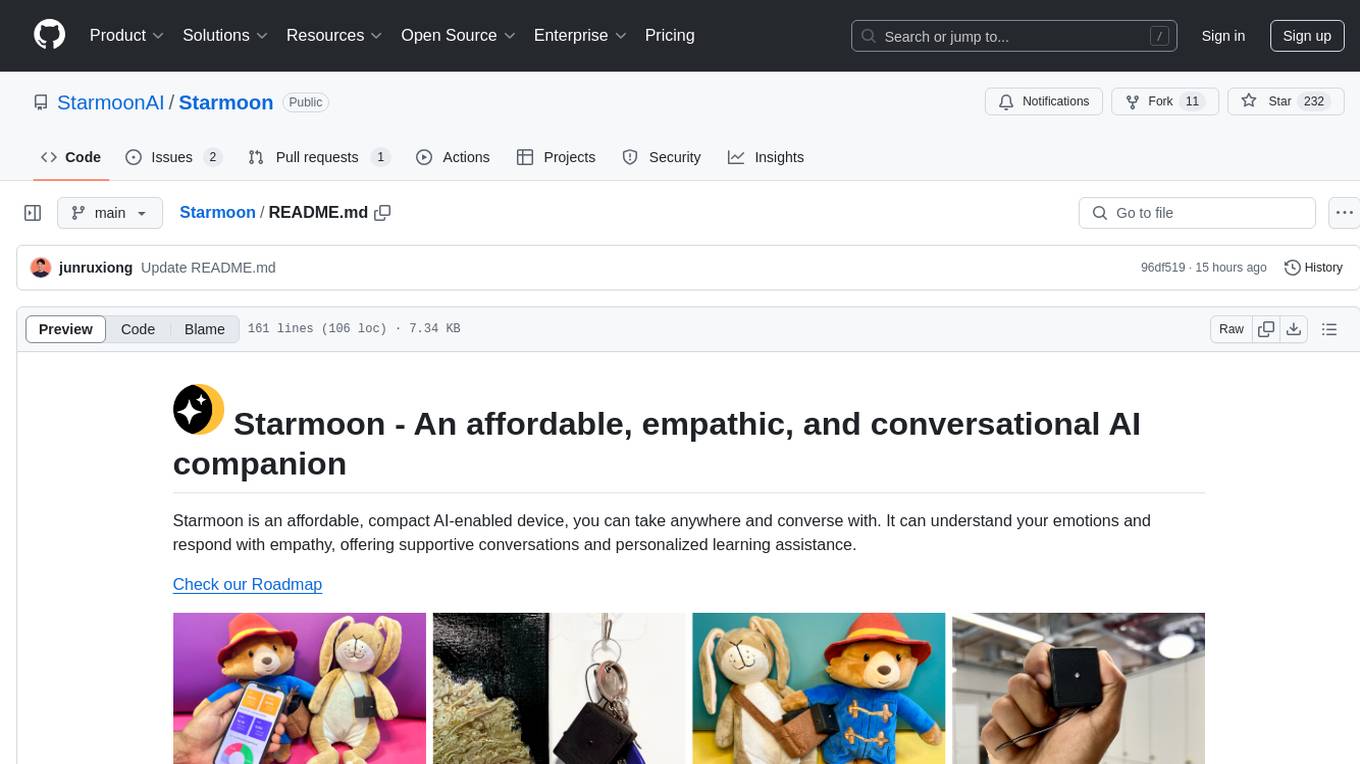
Starmoon
Starmoon is an affordable, compact AI-enabled device that can understand and respond to your emotions with empathy. It offers supportive conversations and personalized learning assistance. The device is cost-effective, voice-enabled, open-source, compact, and aims to reduce screen time. Users can assemble the device themselves using off-the-shelf components and deploy it locally for data privacy. Starmoon integrates various APIs for AI language models, speech-to-text, text-to-speech, and emotion intelligence. The hardware setup involves components like ESP32S3, microphone, amplifier, speaker, LED light, and button, along with software setup instructions for developers. The project also includes a web app, backend API, and background task dashboard for monitoring and management.
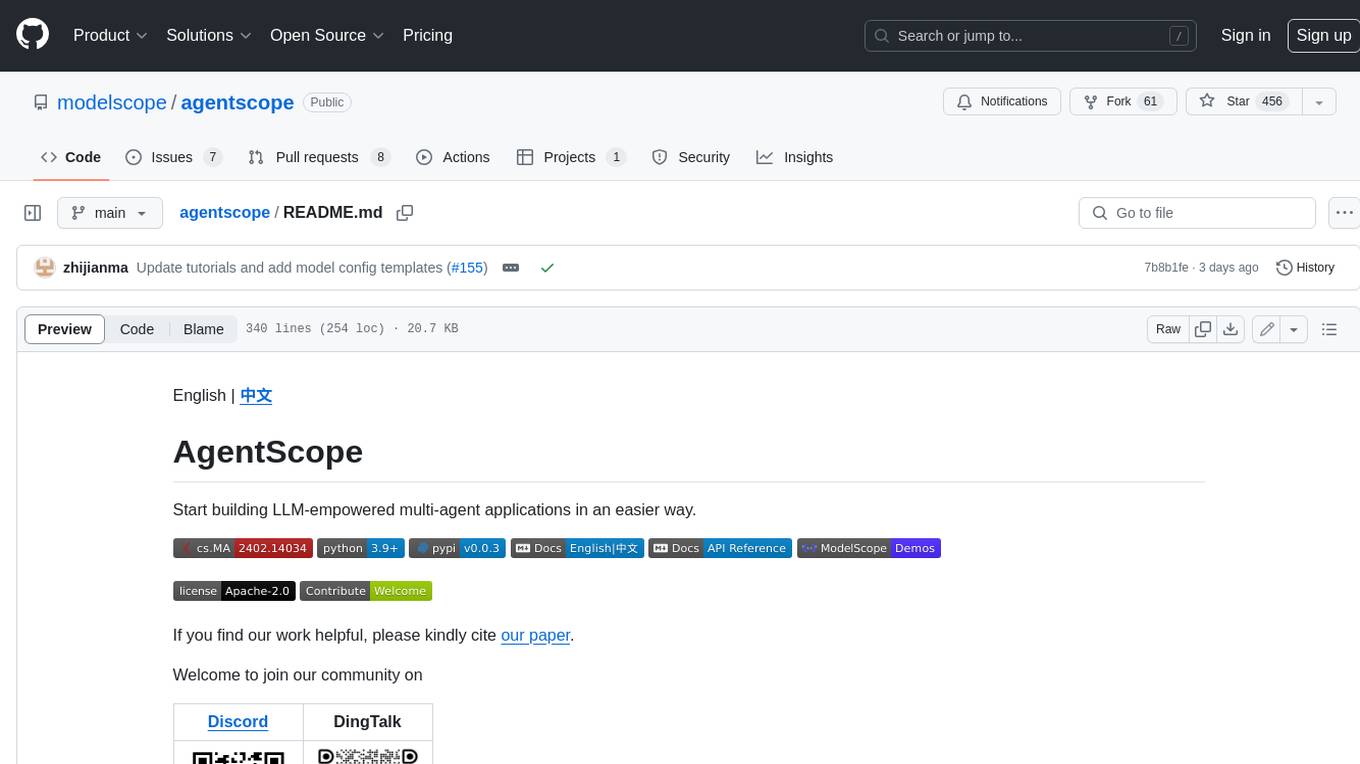
agentscope
AgentScope is a multi-agent platform designed to empower developers to build multi-agent applications with large-scale models. It features three high-level capabilities: Easy-to-Use, High Robustness, and Actor-Based Distribution. AgentScope provides a list of `ModelWrapper` to support both local model services and third-party model APIs, including OpenAI API, DashScope API, Gemini API, and ollama. It also enables developers to rapidly deploy local model services using libraries such as ollama (CPU inference), Flask + Transformers, Flask + ModelScope, FastChat, and vllm. AgentScope supports various services, including Web Search, Data Query, Retrieval, Code Execution, File Operation, and Text Processing. Example applications include Conversation, Game, and Distribution. AgentScope is released under Apache License 2.0 and welcomes contributions.
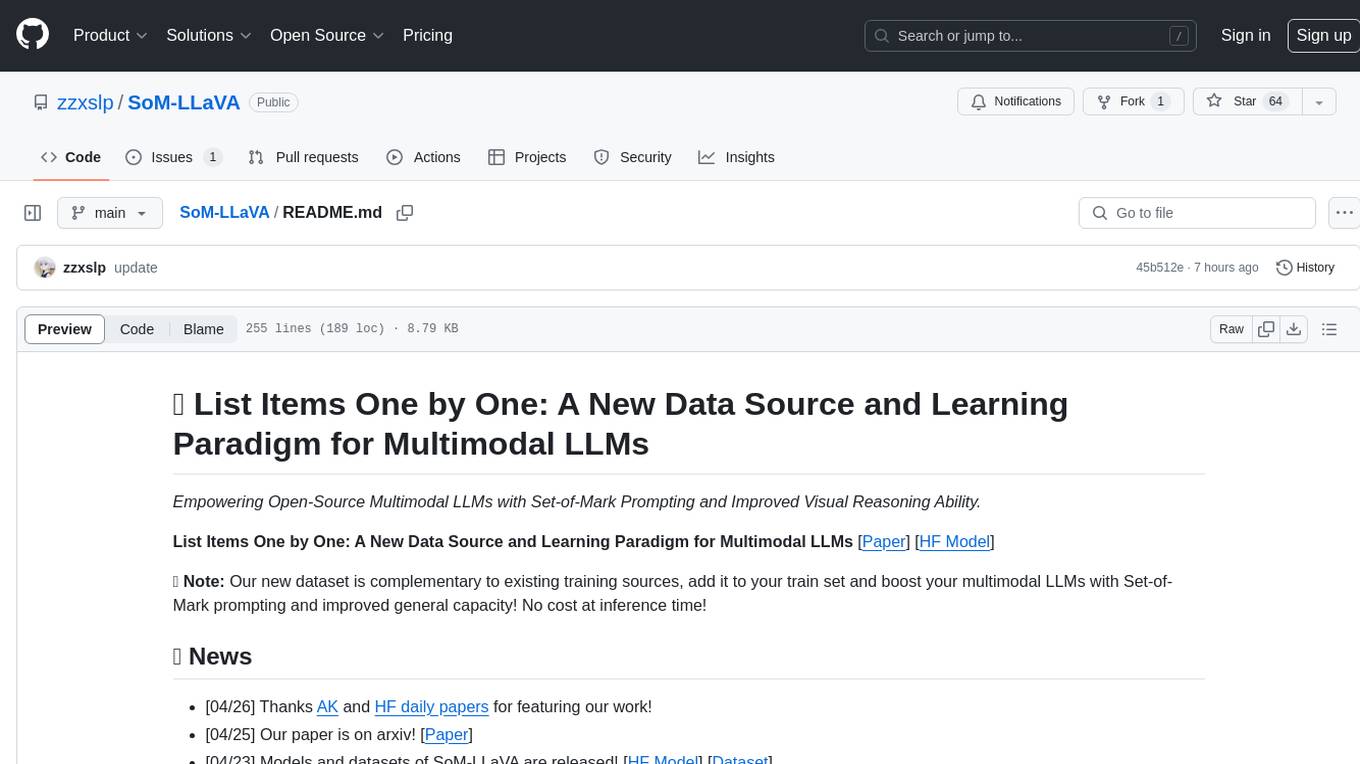
SoM-LLaVA
SoM-LLaVA is a new data source and learning paradigm for Multimodal LLMs, empowering open-source Multimodal LLMs with Set-of-Mark prompting and improved visual reasoning ability. The repository provides a new dataset that is complementary to existing training sources, enhancing multimodal LLMs with Set-of-Mark prompting and improved general capacity. By adding 30k SoM data to the visual instruction tuning stage of LLaVA, the tool achieves 1% to 6% relative improvements on all benchmarks. Users can train SoM-LLaVA via command line and utilize the implementation to annotate COCO images with SoM. Additionally, the tool can be loaded in Huggingface for further usage.
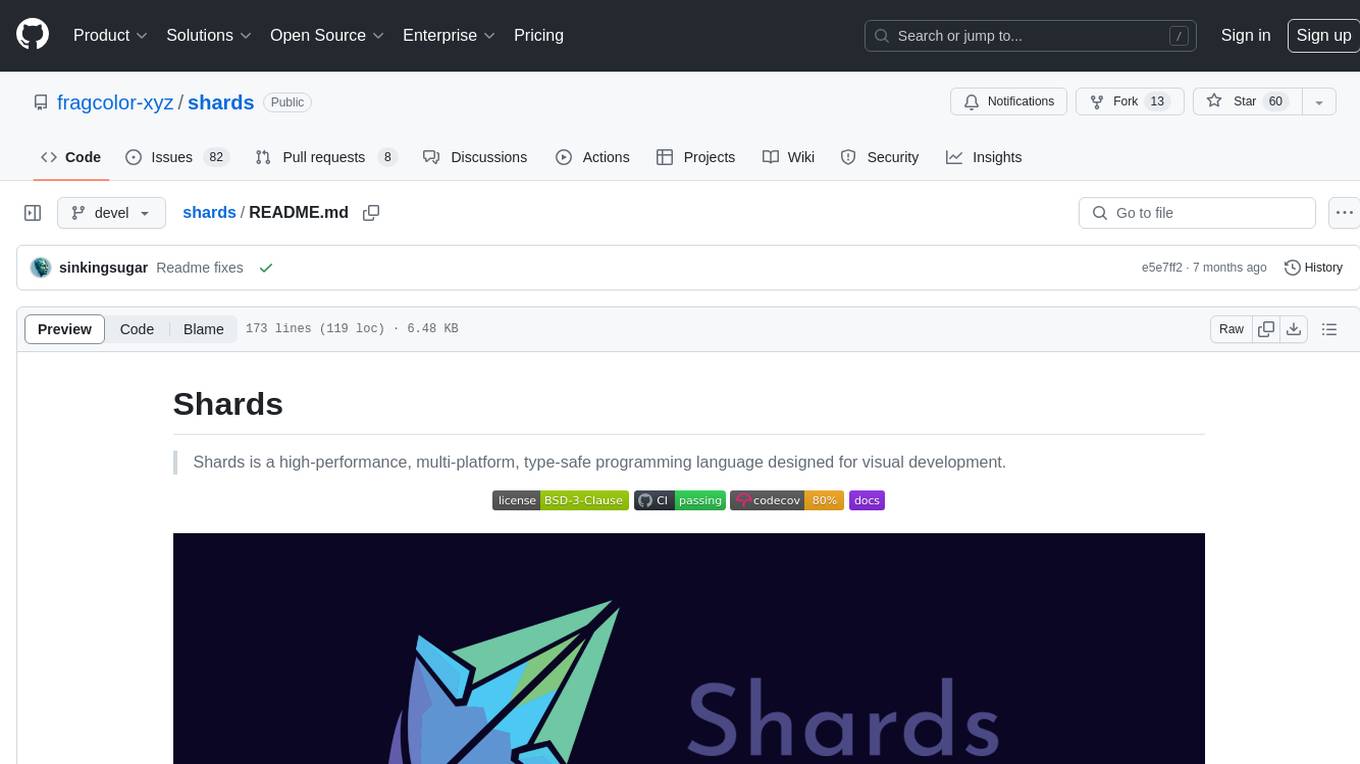
shards
Shards is a high-performance, multi-platform, type-safe programming language designed for visual development. It is a dataflow visual programming language that enables building full-fledged apps and games without traditional coding. Shards features automatic type checking, optimized shard implementations for high performance, and an intuitive visual workflow for beginners. The language allows seamless round-trip engineering between code and visual models, empowering users to create multi-platform apps easily. Shards also powers an upcoming AI-powered game creation system, enabling real-time collaboration and game development in a low to no-code environment.
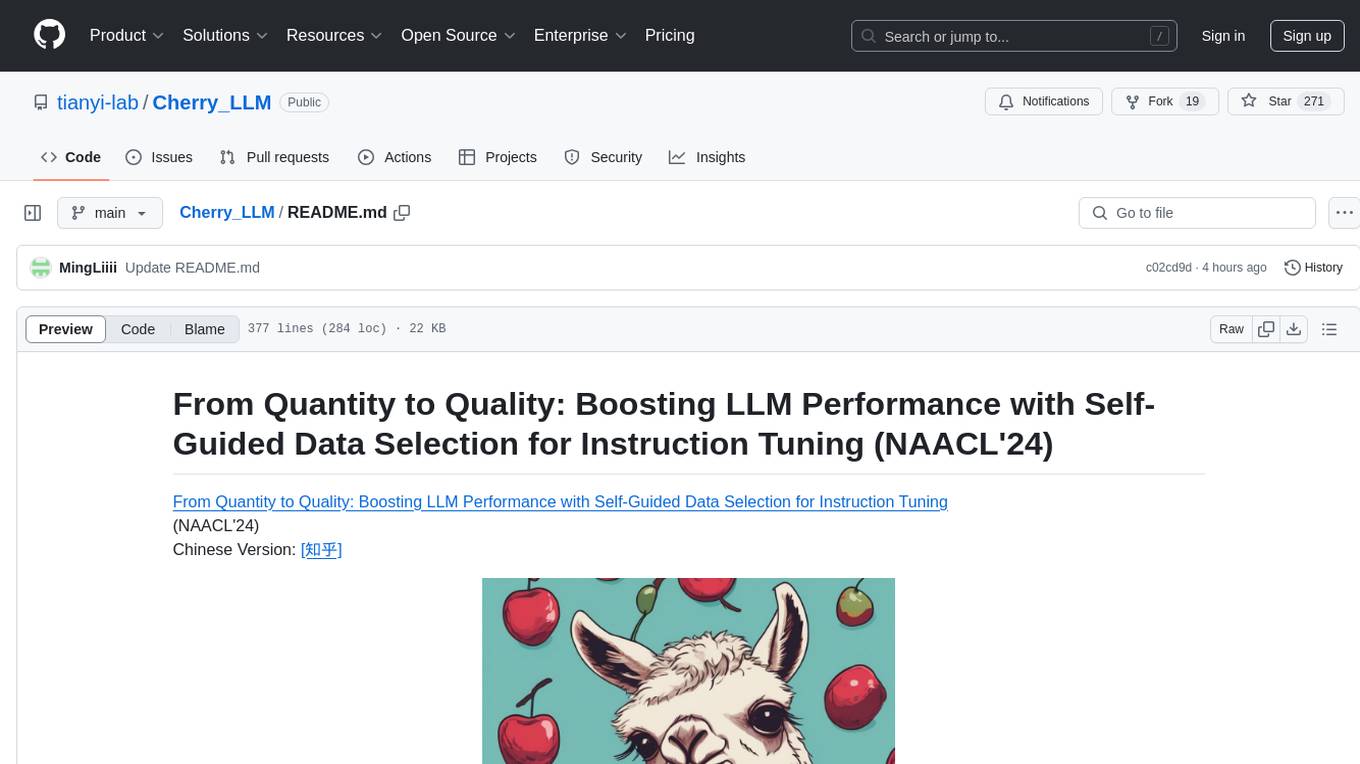
Cherry_LLM
Cherry Data Selection project introduces a self-guided methodology for LLMs to autonomously discern and select cherry samples from open-source datasets, minimizing manual curation and cost for instruction tuning. The project focuses on selecting impactful training samples ('cherry data') to enhance LLM instruction tuning by estimating instruction-following difficulty. The method involves phases like 'Learning from Brief Experience', 'Evaluating Based on Experience', and 'Retraining from Self-Guided Experience' to improve LLM performance.
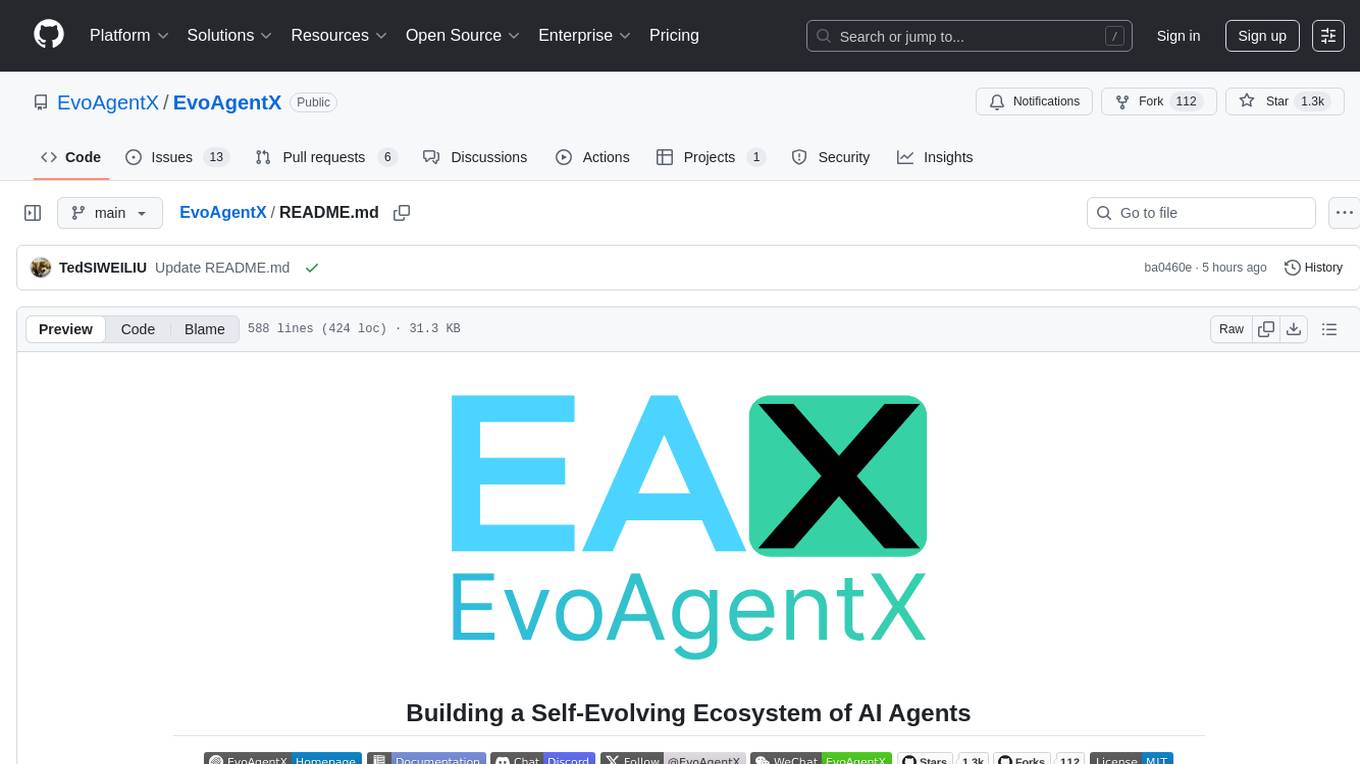
EvoAgentX
EvoAgentX is an open-source framework for building, evaluating, and evolving LLM-based agents or agentic workflows in an automated, modular, and goal-driven manner. It enables developers and researchers to move beyond static prompt chaining or manual workflow orchestration by introducing a self-evolving agent ecosystem. The framework includes features such as agent workflow autoconstruction, built-in evaluation, self-evolution engine, plug-and-play compatibility, comprehensive built-in tools, memory module support, and human-in-the-loop interactions.

airunner
AI Runner is a multi-modal AI interface that allows users to run open-source large language models and AI image generators on their own hardware. The tool provides features such as voice-based chatbot conversations, text-to-speech, speech-to-text, vision-to-text, text generation with large language models, image generation capabilities, image manipulation tools, utility functions, and more. It aims to provide a stable and user-friendly experience with security updates, a new UI, and a streamlined installation process. The application is designed to run offline on users' hardware without relying on a web server, offering a smooth and responsive user experience.
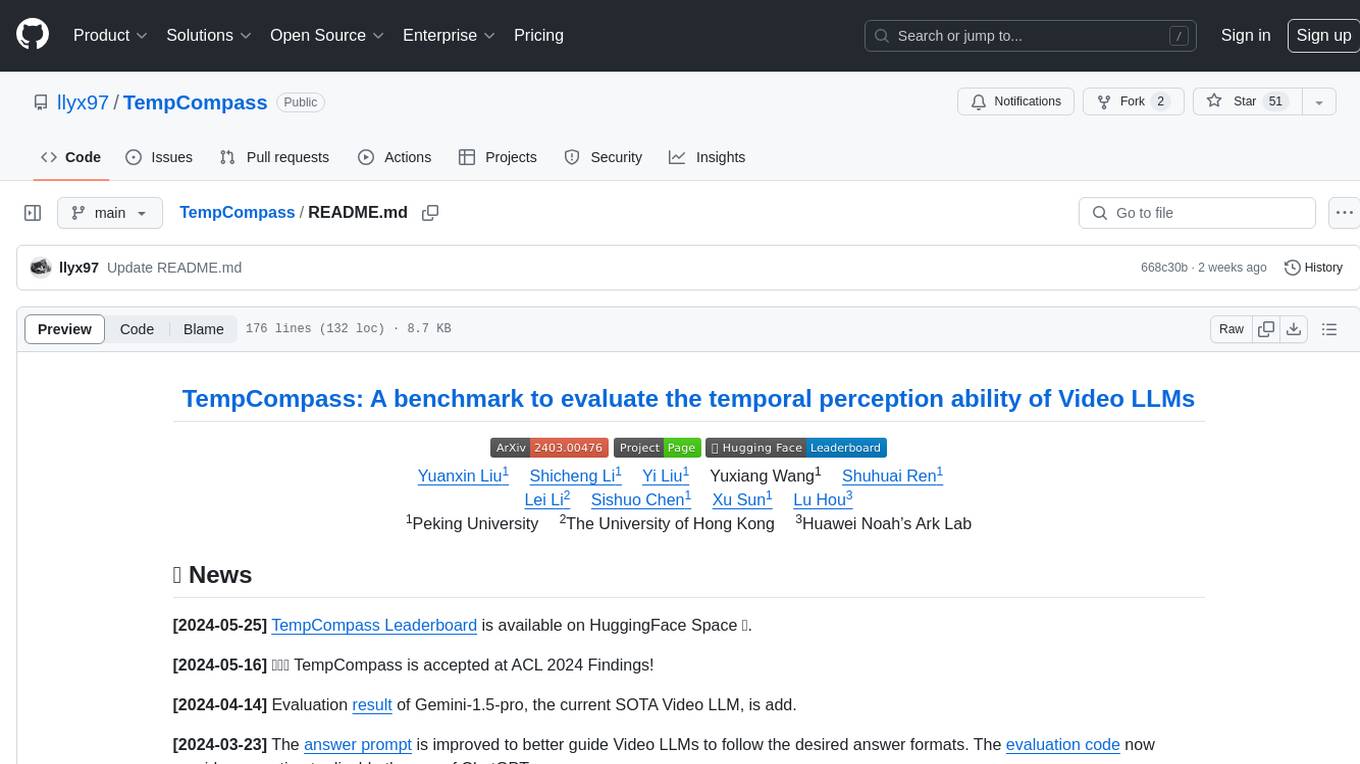
TempCompass
TempCompass is a benchmark designed to evaluate the temporal perception ability of Video LLMs. It encompasses a diverse set of temporal aspects and task formats to comprehensively assess the capability of Video LLMs in understanding videos. The benchmark includes conflicting videos to prevent models from relying on single-frame bias and language priors. Users can clone the repository, install required packages, prepare data, run inference using examples like Video-LLaVA and Gemini, and evaluate the performance of their models across different tasks such as Multi-Choice QA, Yes/No QA, Caption Matching, and Caption Generation.
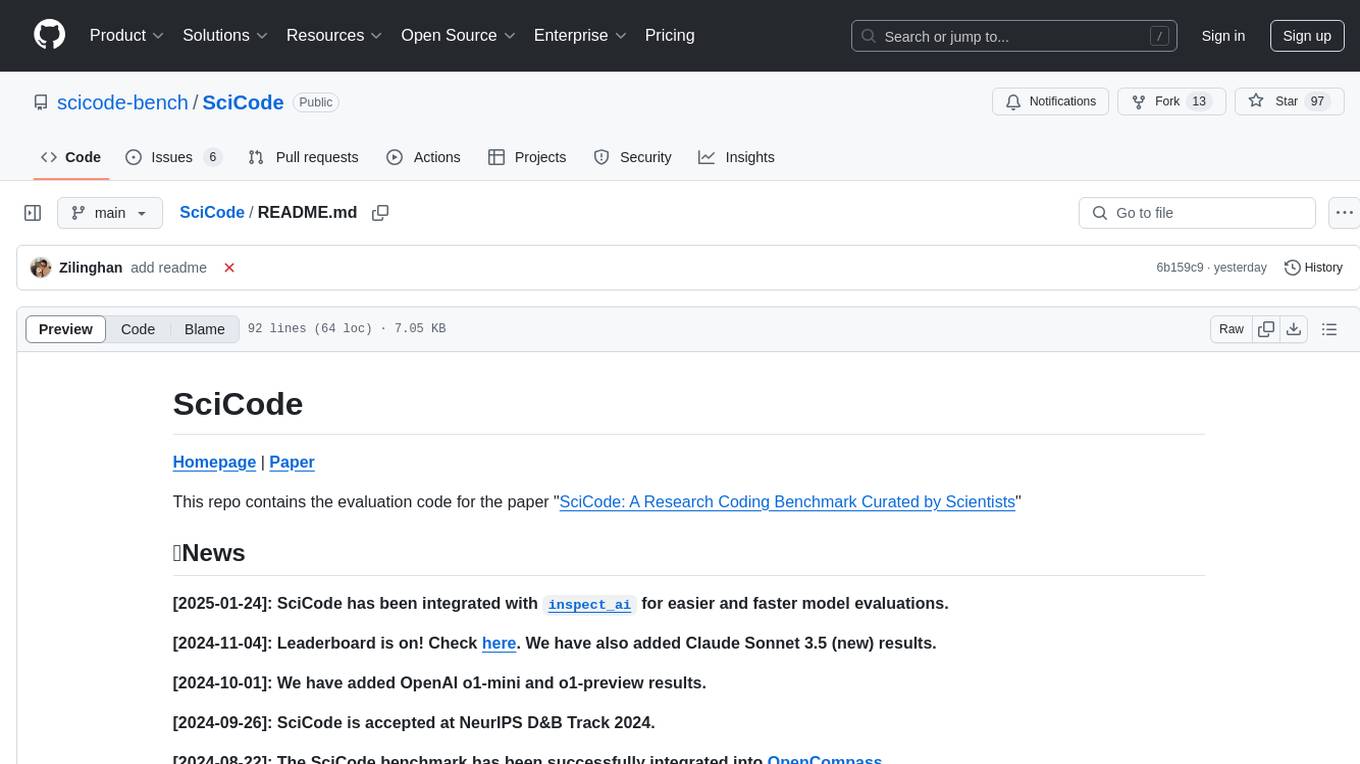
SciCode
SciCode is a challenging benchmark designed to evaluate the capabilities of language models (LMs) in generating code for solving realistic scientific research problems. It contains 338 subproblems decomposed from 80 challenging main problems across 16 subdomains from 6 domains. The benchmark offers optional descriptions specifying useful scientific background information and scientist-annotated gold-standard solutions and test cases for evaluation. SciCode demonstrates a realistic workflow of identifying critical science concepts and facts and transforming them into computation and simulation code, aiming to help showcase LLMs' progress towards assisting scientists and contribute to the future building and evaluation of scientific AI.

WeKnora
WeKnora is a document understanding and semantic retrieval framework based on large language models (LLM), designed specifically for scenarios with complex structures and heterogeneous content. The framework adopts a modular architecture, integrating multimodal preprocessing, semantic vector indexing, intelligent recall, and large model generation reasoning to build an efficient and controllable document question-answering process. The core retrieval process is based on the RAG (Retrieval-Augmented Generation) mechanism, combining context-relevant segments with language models to achieve higher-quality semantic answers. It supports various document formats, intelligent inference, flexible extension, efficient retrieval, ease of use, and security and control. Suitable for enterprise knowledge management, scientific literature analysis, product technical support, legal compliance review, and medical knowledge assistance.

auto-news
Auto-News is an automatic news aggregator tool that utilizes Large Language Models (LLM) to pull information from various sources such as Tweets, RSS feeds, YouTube videos, web articles, Reddit, and journal notes. The tool aims to help users efficiently read and filter content based on personal interests, providing a unified reading experience and organizing information effectively. It features feed aggregation with summarization, transcript generation for videos and articles, noise reduction, task organization, and deep dive topic exploration. The tool supports multiple LLM backends, offers weekly top-k aggregations, and can be deployed on Linux/MacOS using docker-compose or Kubernetes.
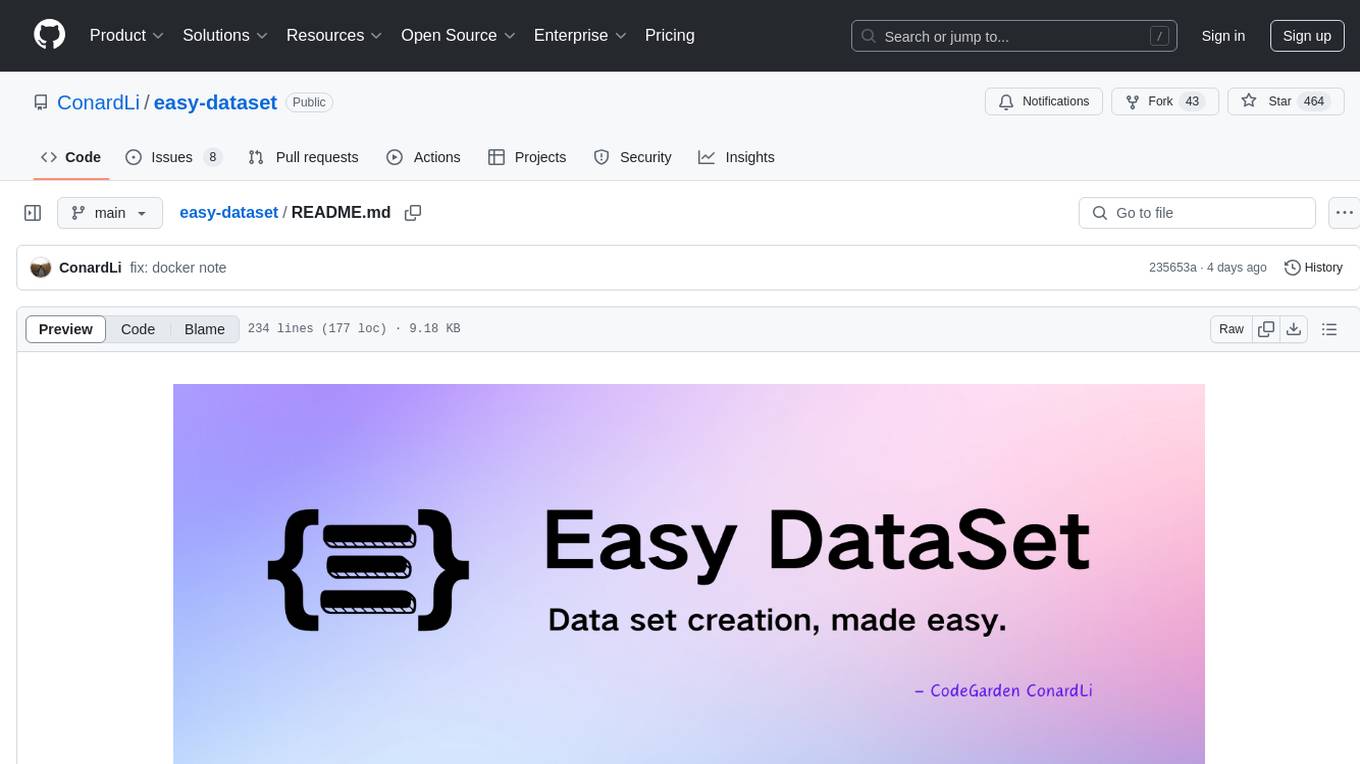
easy-dataset
Easy Dataset is a specialized application designed to streamline the creation of fine-tuning datasets for Large Language Models (LLMs). It offers an intuitive interface for uploading domain-specific files, intelligently splitting content, generating questions, and producing high-quality training data for model fine-tuning. With Easy Dataset, users can transform domain knowledge into structured datasets compatible with all OpenAI-format compatible LLM APIs, making the fine-tuning process accessible and efficient.
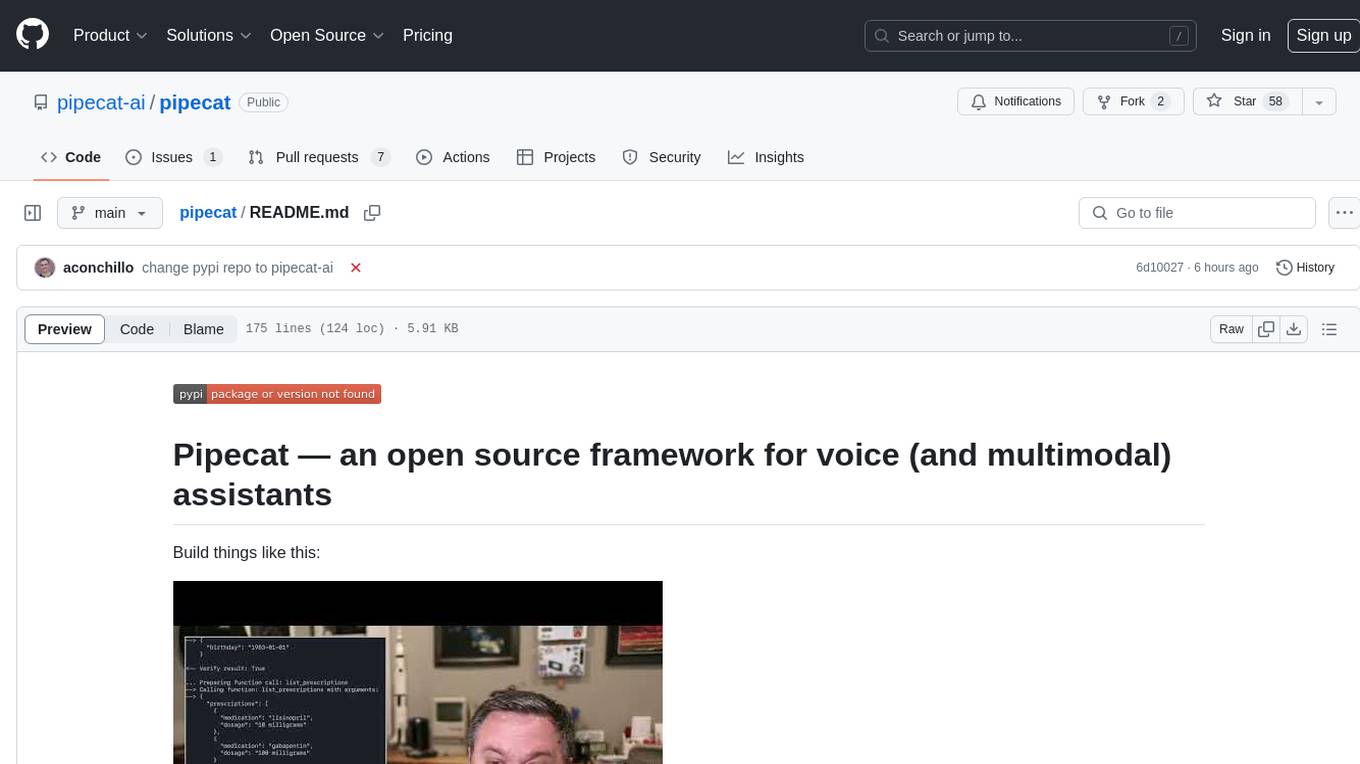
pipecat
Pipecat is an open-source framework designed for building generative AI voice bots and multimodal assistants. It provides code building blocks for interacting with AI services, creating low-latency data pipelines, and transporting audio, video, and events over the Internet. Pipecat supports various AI services like speech-to-text, text-to-speech, image generation, and vision models. Users can implement new services and contribute to the framework. Pipecat aims to simplify the development of applications like personal coaches, meeting assistants, customer support bots, and more by providing a complete framework for integrating AI services.
For similar tasks
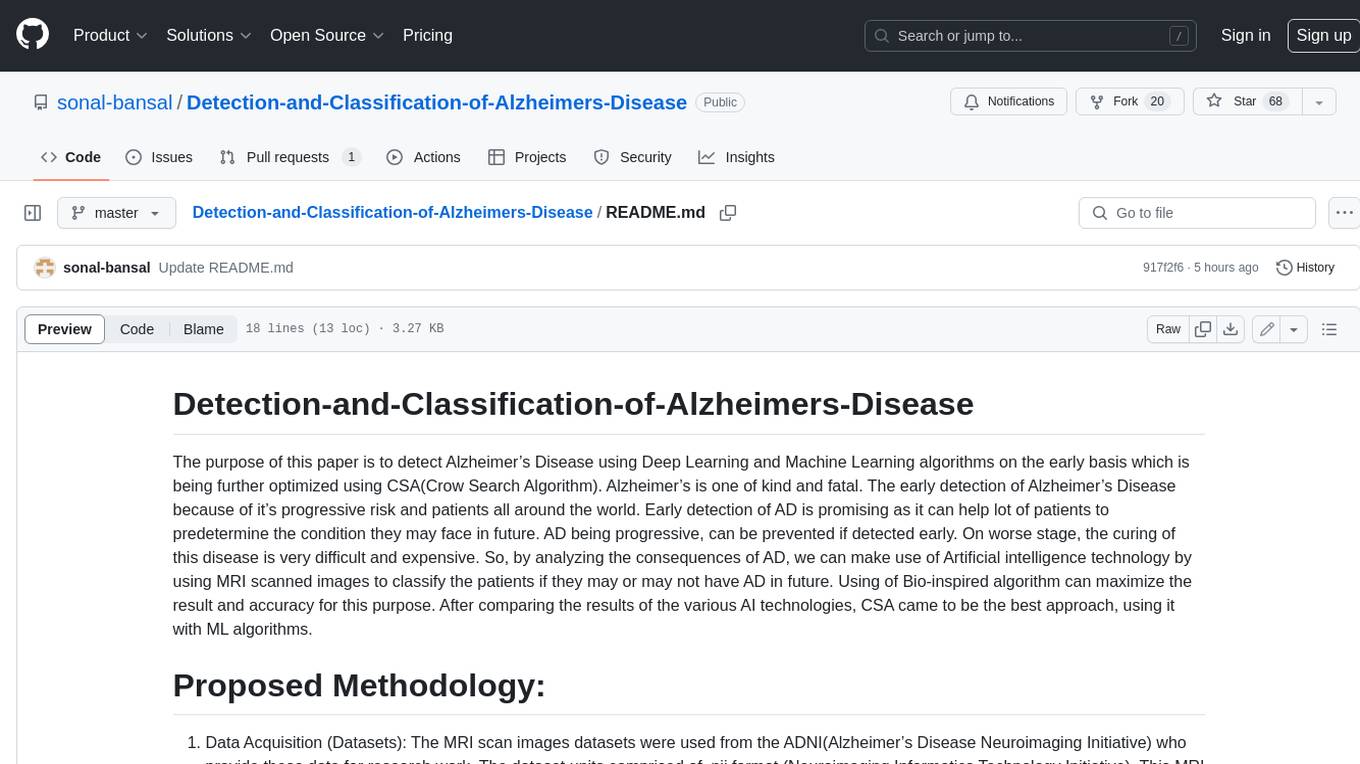
Detection-and-Classification-of-Alzheimers-Disease
This tool is designed to detect and classify Alzheimer's Disease using Deep Learning and Machine Learning algorithms on an early basis, which is further optimized using the Crow Search Algorithm (CSA). Alzheimer's is a fatal disease, and early detection is crucial for patients to predetermine their condition and prevent its progression. By analyzing MRI scanned images using Artificial Intelligence technology, this tool can classify patients who may or may not develop AD in the future. The CSA algorithm, combined with ML algorithms, has proven to be the most effective approach for this purpose.
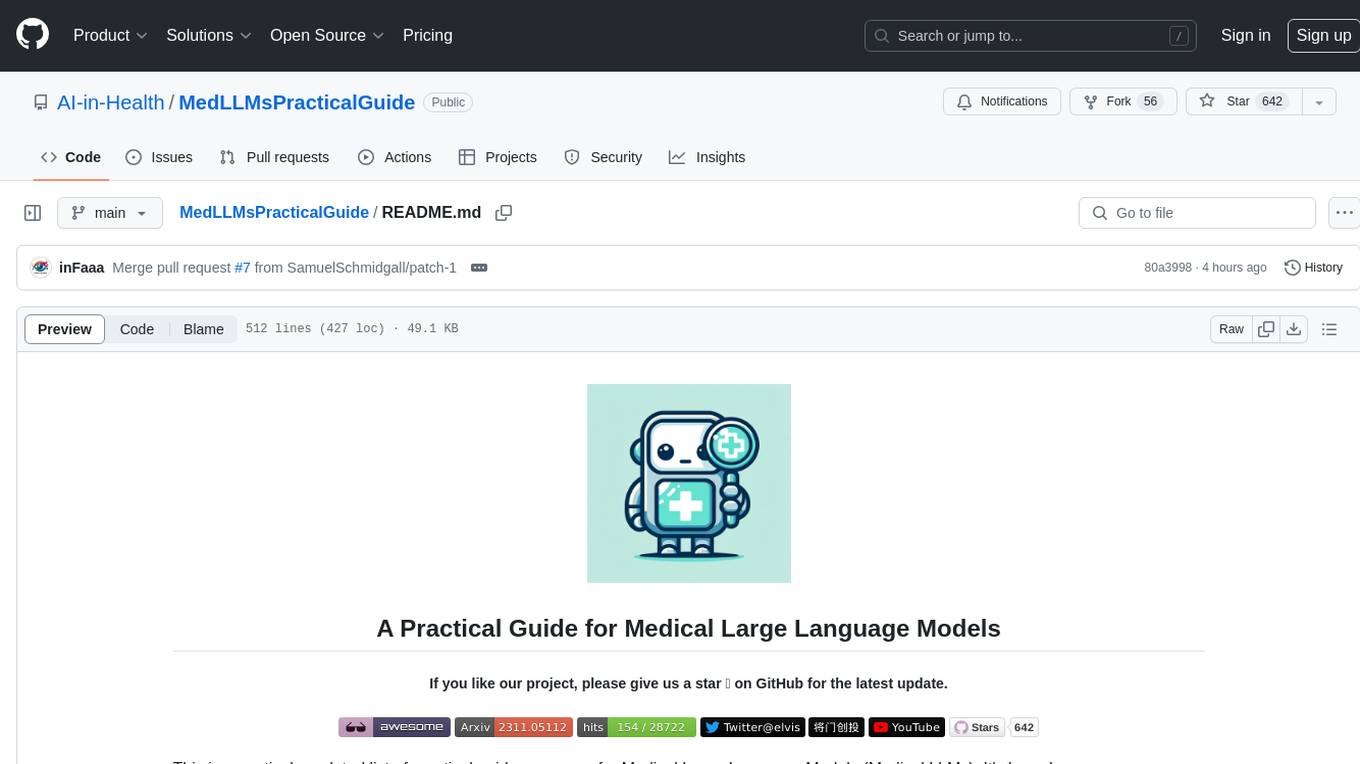
MedLLMsPracticalGuide
This repository serves as a practical guide for Medical Large Language Models (Medical LLMs) and provides resources, surveys, and tools for building, fine-tuning, and utilizing LLMs in the medical domain. It covers a wide range of topics including pre-training, fine-tuning, downstream biomedical tasks, clinical applications, challenges, future directions, and more. The repository aims to provide insights into the opportunities and challenges of LLMs in medicine and serve as a practical resource for constructing effective medical LLMs.

AMIE-pytorch
Implementation of the general framework for AMIE, from the paper Towards Conversational Diagnostic AI, out of Google Deepmind. This repository provides a Pytorch implementation of the AMIE framework, aimed at enabling conversational diagnostic AI. It is a work in progress and welcomes collaboration from individuals with a background in deep learning and an interest in medical applications.

HuatuoGPT-o1
HuatuoGPT-o1 is a medical language model designed for advanced medical reasoning. It can identify mistakes, explore alternative strategies, and refine answers. The model leverages verifiable medical problems and a specialized medical verifier to guide complex reasoning trajectories and enhance reasoning through reinforcement learning. The repository provides access to models, data, and code for HuatuoGPT-o1, allowing users to deploy the model for medical reasoning tasks.
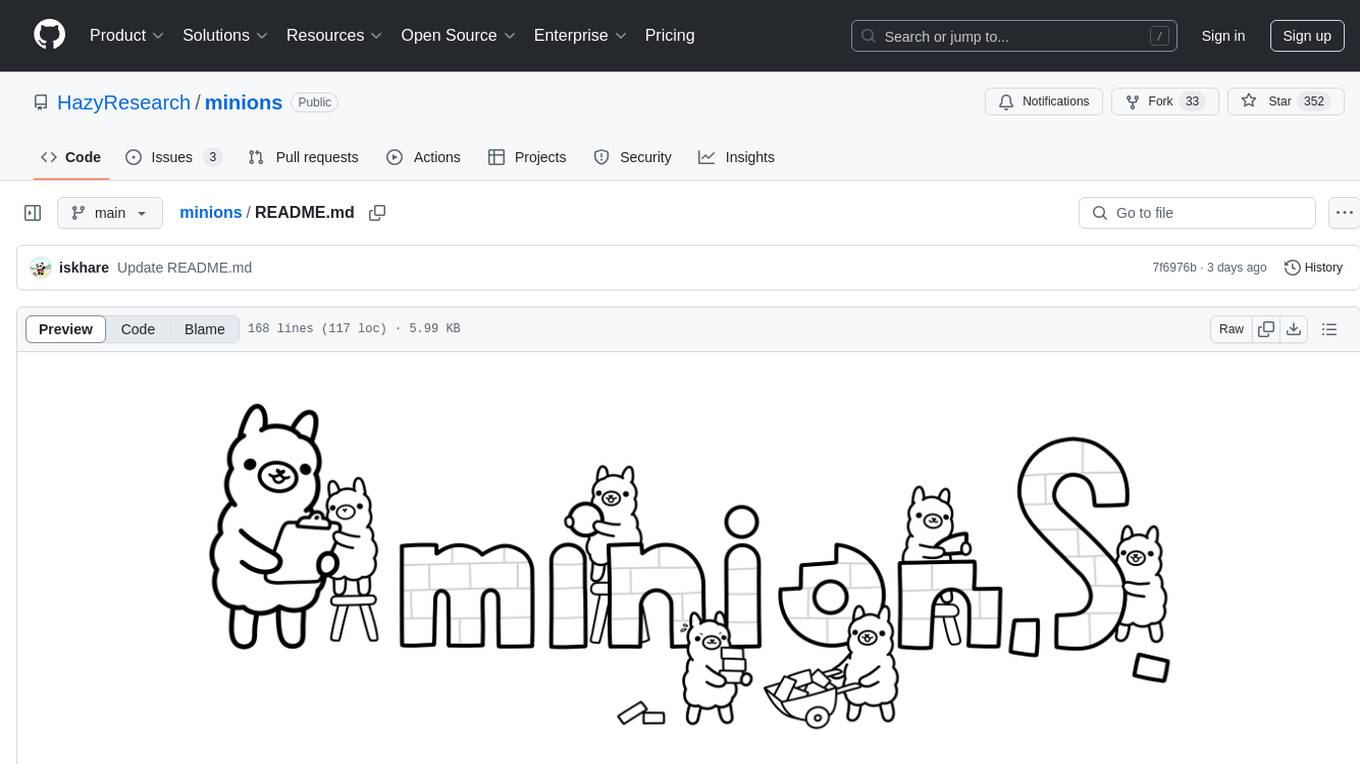
minions
Minions is a communication protocol that enables small on-device models to collaborate with frontier models in the cloud. By only reading long contexts locally, it reduces cloud costs with minimal or no quality degradation. The repository provides a demonstration of the protocol.
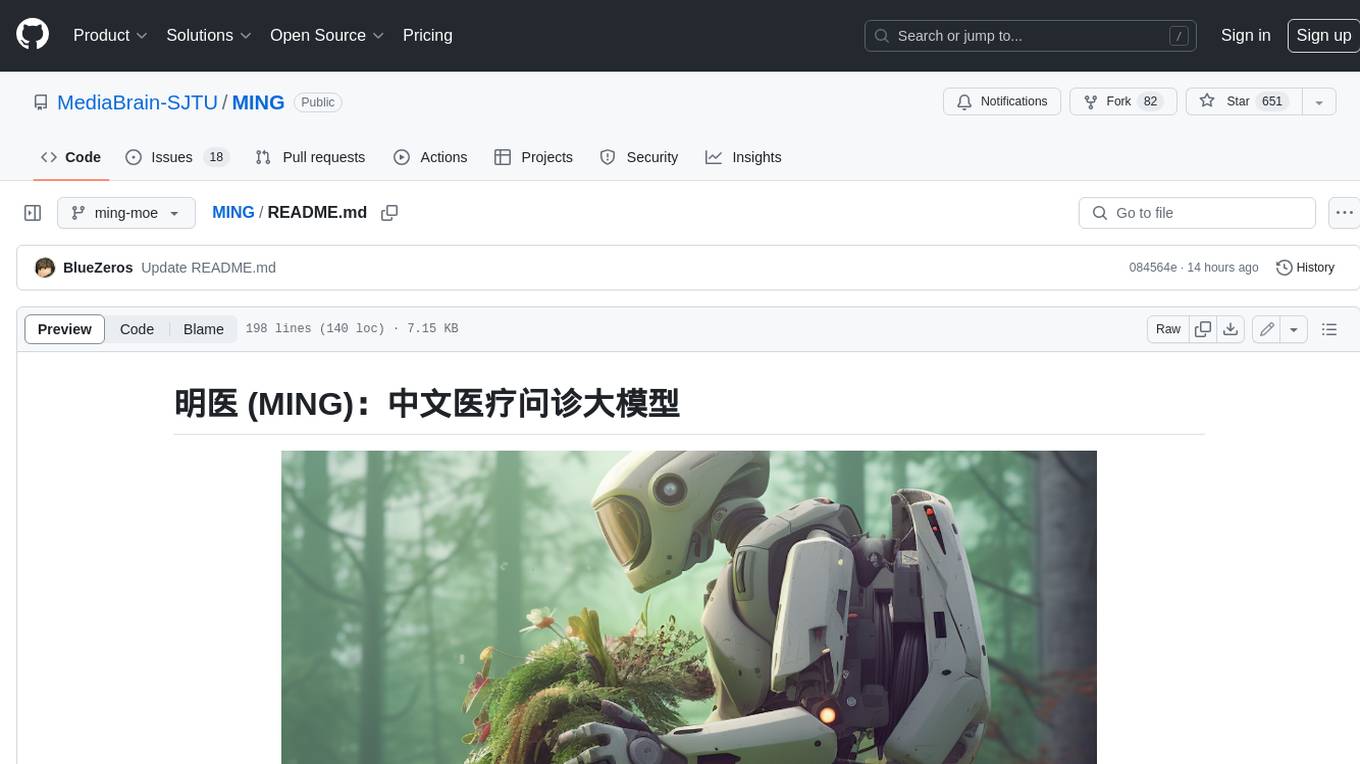
MING
MING is an open-sourced Chinese medical consultation model fine-tuned based on medical instructions. The main functions of the model are as follows: Medical Q&A: answering medical questions and analyzing cases. Intelligent consultation: giving diagnosis results and suggestions after multiple rounds of consultation.
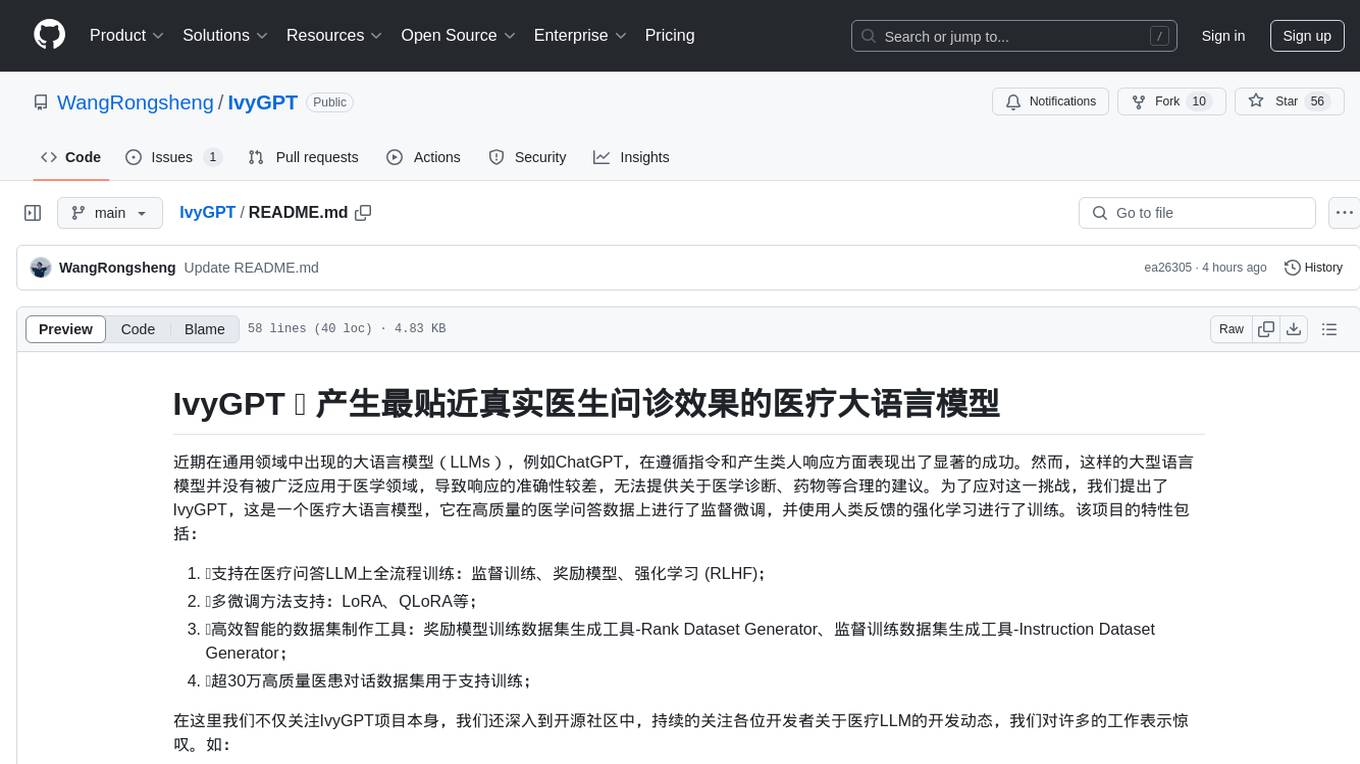
IvyGPT
IvyGPT is a medical large language model that aims to generate the most realistic doctor consultation effects. It has been fine-tuned on high-quality medical Q&A data and trained using human feedback reinforcement learning. The project features full-process training on medical Q&A LLM, multiple fine-tuning methods support, efficient dataset creation tools, and a dataset of over 300,000 high-quality doctor-patient dialogues for training.
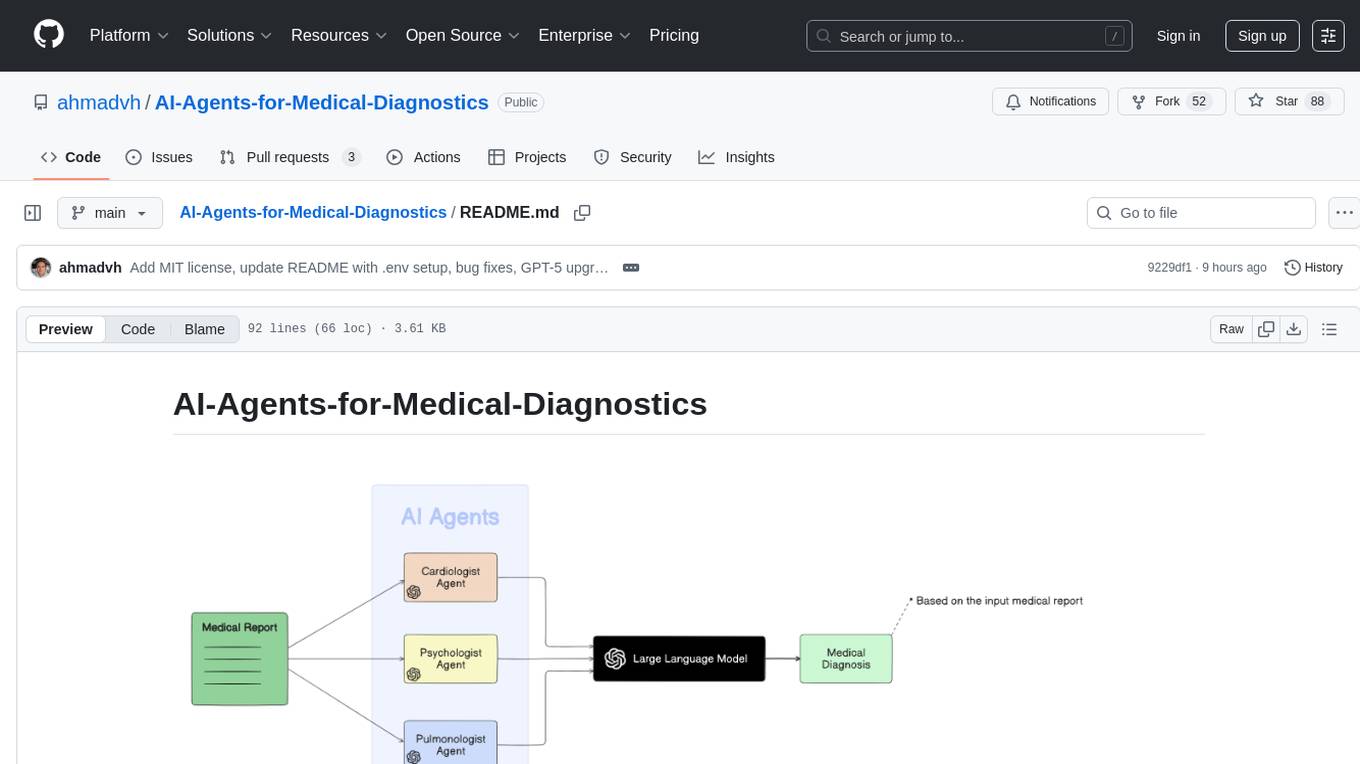
AI-Agents-for-Medical-Diagnostics
AI Agents for Medical Diagnostics is a repository containing a collection of machine learning models and algorithms designed to assist in medical diagnosis. The tools provided in this repository are specifically tailored for analyzing medical data and making predictions related to various health conditions. By leveraging the power of artificial intelligence, these agents aim to improve the accuracy and efficiency of diagnostic processes in the medical field. Researchers, healthcare professionals, and data scientists can benefit from the resources available in this repository to develop innovative solutions for diagnosing illnesses and predicting patient outcomes.
For similar jobs

HuatuoGPT-o1
HuatuoGPT-o1 is a medical language model designed for advanced medical reasoning. It can identify mistakes, explore alternative strategies, and refine answers. The model leverages verifiable medical problems and a specialized medical verifier to guide complex reasoning trajectories and enhance reasoning through reinforcement learning. The repository provides access to models, data, and code for HuatuoGPT-o1, allowing users to deploy the model for medical reasoning tasks.
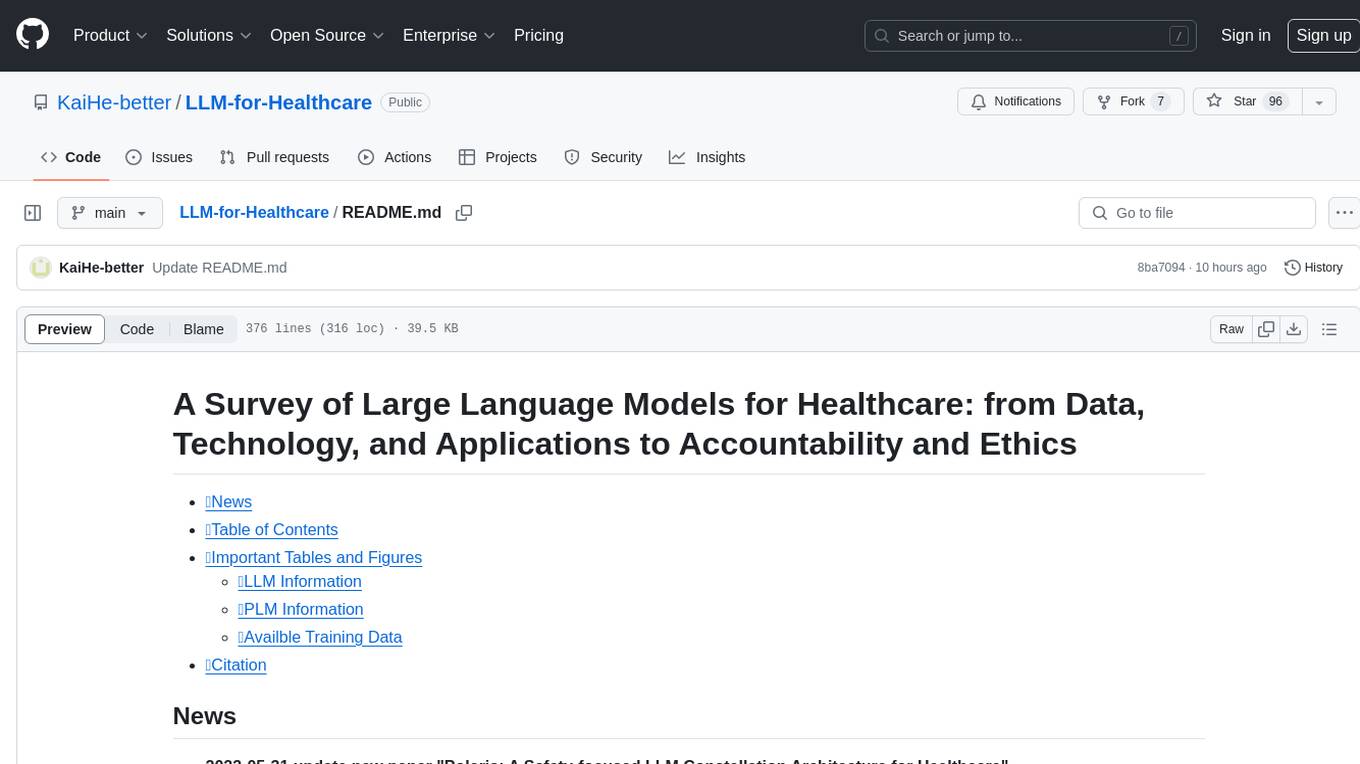
LLM-for-Healthcare
The repository 'LLM-for-Healthcare' provides a comprehensive survey of large language models (LLMs) for healthcare, covering data, technology, applications, and accountability and ethics. It includes information on various LLM models, training data, evaluation methods, and computation costs. The repository also discusses tasks such as NER, text classification, question answering, dialogue systems, and generation of medical reports from images in the healthcare domain.
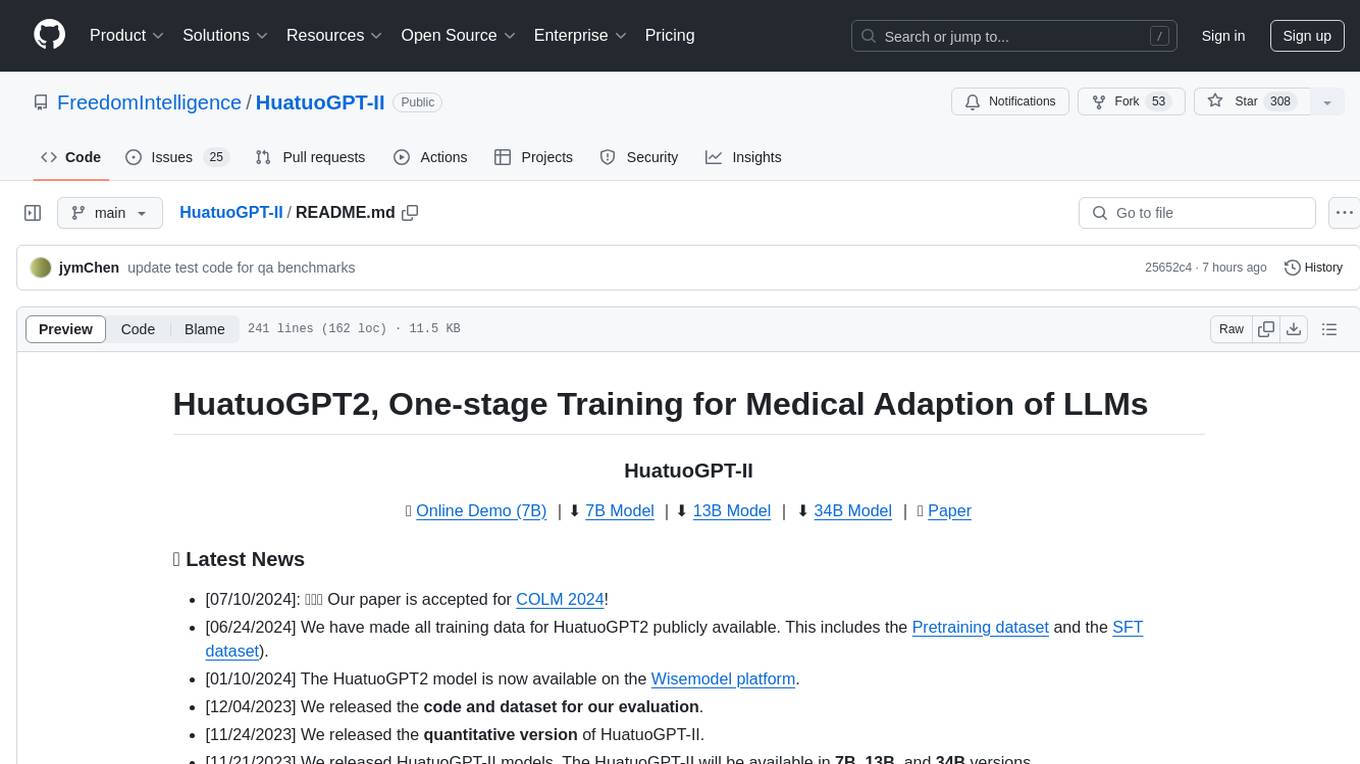
HuatuoGPT-II
HuatuoGPT2 is an innovative domain-adapted medical large language model that excels in medical knowledge and dialogue proficiency. It showcases state-of-the-art performance in various medical benchmarks, surpassing GPT-4 in expert evaluations and fresh medical licensing exams. The open-source release includes HuatuoGPT2 models in 7B, 13B, and 34B versions, training code for one-stage adaptation, partial pre-training and fine-tuning instructions, and evaluation methods for medical response capabilities and professional pharmacist exams. The tool aims to enhance LLM capabilities in the Chinese medical field through open-source principles.
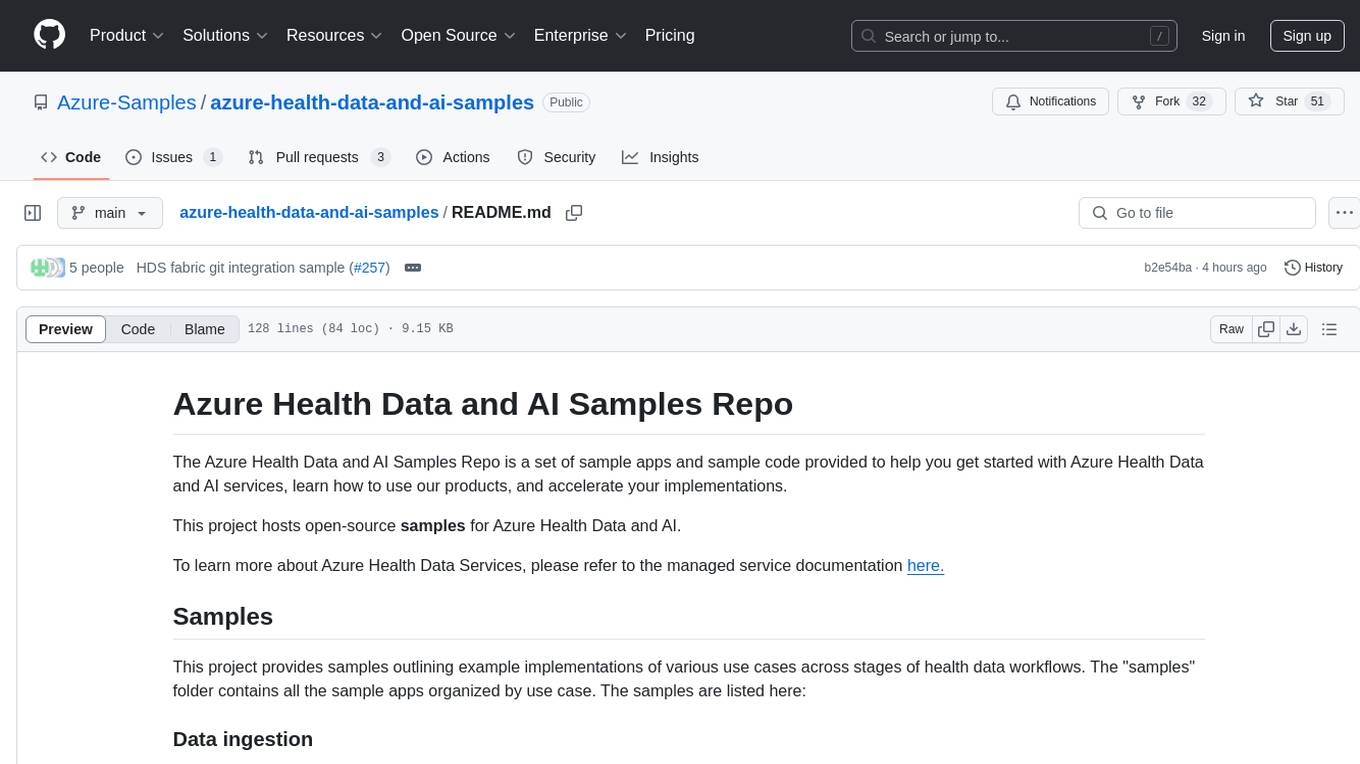
azure-health-data-and-ai-samples
The Azure Health Data and AI Samples Repo is a collection of sample apps and code to help users start with Azure Health Data and AI services, learn product usage, and speed up implementations. It includes samples for various health data workflows, such as data ingestion, analytics, machine learning, SMART on FHIR, patient services, FHIR service integration, Azure AD B2C access, DICOM service, MedTech service, and healthcare data solutions in Microsoft Fabric. These samples are simplified scenarios for testing purposes only.
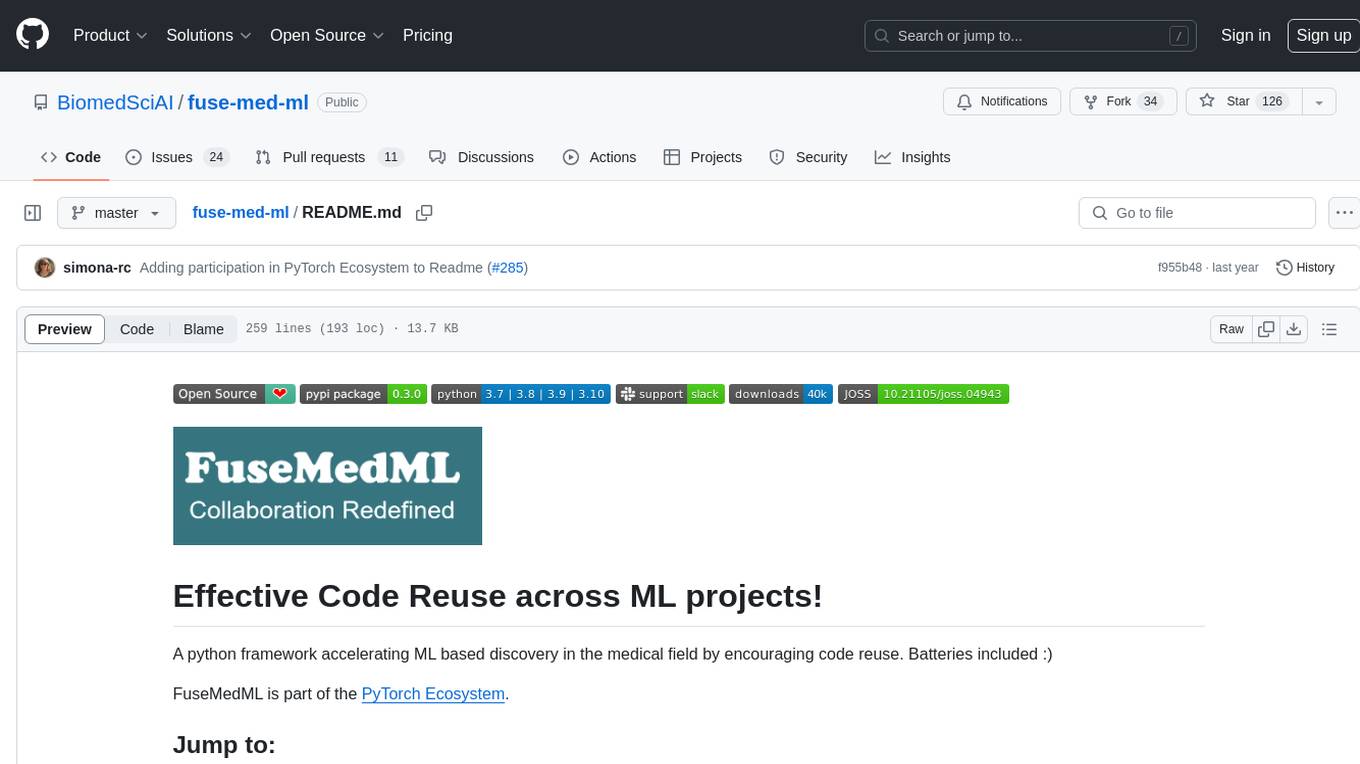
fuse-med-ml
FuseMedML is a Python framework designed to accelerate machine learning-based discovery in the medical field by promoting code reuse. It provides a flexible design concept where data is stored in a nested dictionary, allowing easy handling of multi-modality information. The framework includes components for creating custom models, loss functions, metrics, and data processing operators. Additionally, FuseMedML offers 'batteries included' key components such as fuse.data for data processing, fuse.eval for model evaluation, and fuse.dl for reusable deep learning components. It supports PyTorch and PyTorch Lightning libraries and encourages the creation of domain extensions for specific medical domains.

MedLLMsPracticalGuide
This repository serves as a practical guide for Medical Large Language Models (Medical LLMs) and provides resources, surveys, and tools for building, fine-tuning, and utilizing LLMs in the medical domain. It covers a wide range of topics including pre-training, fine-tuning, downstream biomedical tasks, clinical applications, challenges, future directions, and more. The repository aims to provide insights into the opportunities and challenges of LLMs in medicine and serve as a practical resource for constructing effective medical LLMs.
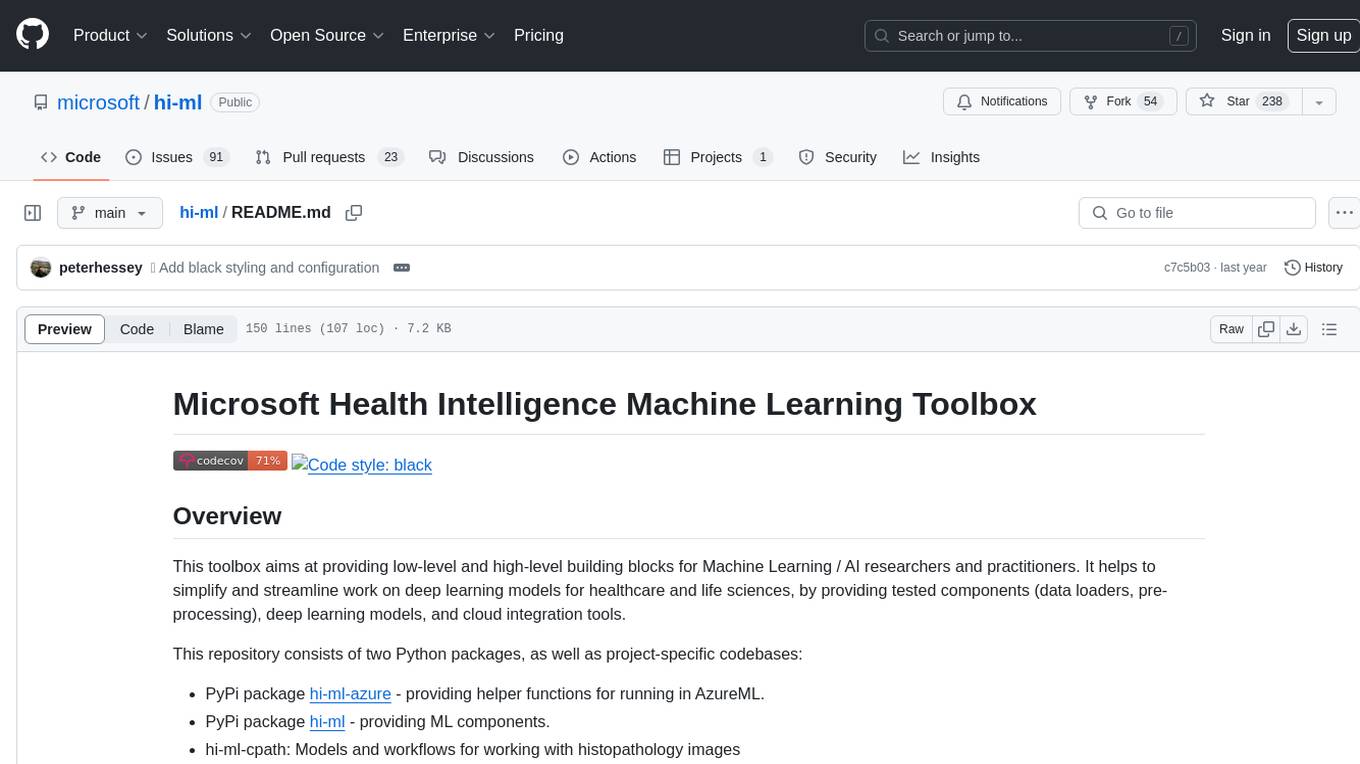
hi-ml
The Microsoft Health Intelligence Machine Learning Toolbox is a repository that provides low-level and high-level building blocks for Machine Learning / AI researchers and practitioners. It simplifies and streamlines work on deep learning models for healthcare and life sciences by offering tested components such as data loaders, pre-processing tools, deep learning models, and cloud integration utilities. The repository includes two Python packages, 'hi-ml-azure' for helper functions in AzureML, 'hi-ml' for ML components, and 'hi-ml-cpath' for models and workflows related to histopathology images.
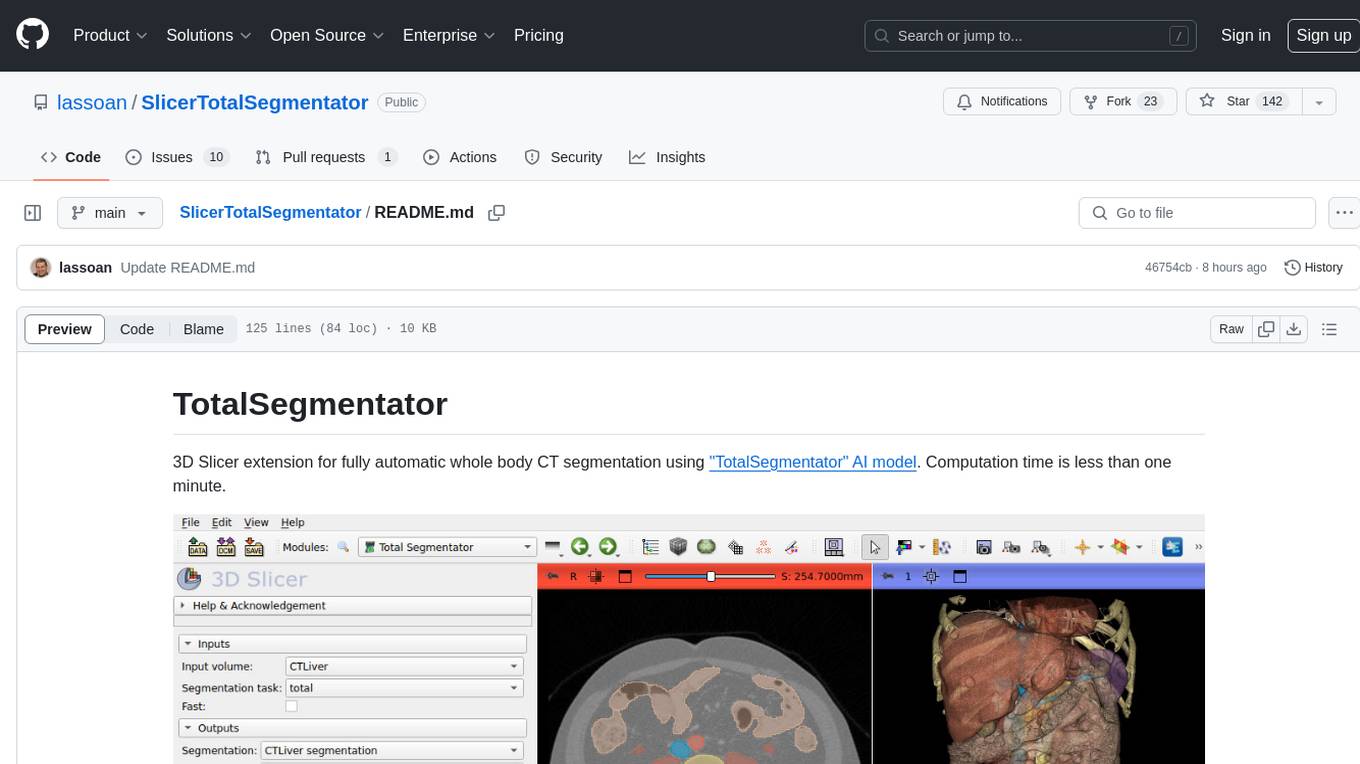
SlicerTotalSegmentator
TotalSegmentator is a 3D Slicer extension designed for fully automatic whole body CT segmentation using the 'TotalSegmentator' AI model. The computation time is less than one minute, making it efficient for research purposes. Users can set up GPU acceleration for faster segmentation. The tool provides a user-friendly interface for loading CT images, creating segmentations, and displaying results in 3D. Troubleshooting steps are available for common issues such as failed computation, GPU errors, and inaccurate segmentations. Contributions to the extension are welcome, following 3D Slicer contribution guidelines.
